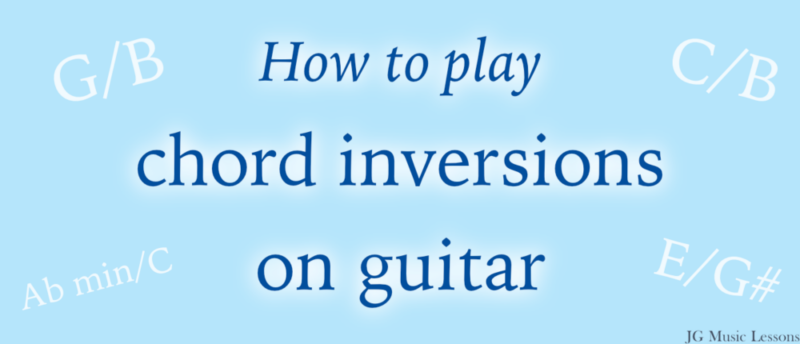Did you know there are several ways to play the same chord using different bass notes? In this lesson, we are exploring how to play chord inversions on the guitar.
Using inversions will give you different ways of hearing a chord. They can also make your chords sound more interesting when you use them to connect to other chords.
In this lesson, we’ll cover the Major and minor chord inversion shapes starting on the 6th, and 5th strings and then cover some chord progression examples to start applying them in your playing!
Let’s first cover some important terms and break down the music theory to start learning your chord inversions!
What is a chord inversion?
A chord inversion is when you have a chord that uses a bass note that is different from the root note. The two inversions used for triads chords are the 1st inversion, meaning the 3rd of the chord is in the bass (lowest note of the chord). 2nd inversion means that the 5th of the chord is the bass note.
For example, in the key of C we have:
- C Major chord (root position): C, E, G
- C Major chord 1st inversion: E, G, C
- C Major chord 2nd inversion: G, C, E
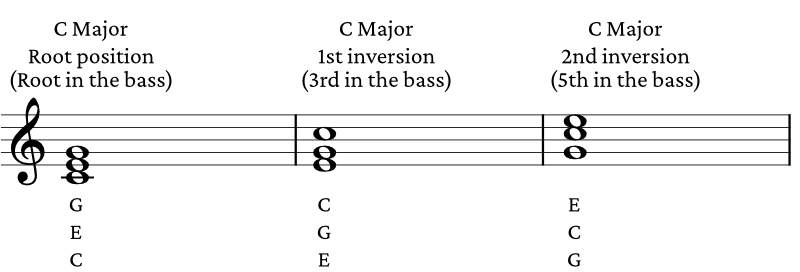
An important thing to note is that although the bass note changes according to the inversion, the other notes of the chord can be in varying orders. You can also drop the 2nd note to the bass to create spread triads (see lesson here).
As you’ll see in the charts ahead, a lot of times some of the notes in the chord get doubled in a given shape. That is normal as long you have the right bass note.
If needed, review this other lesson on triads to better understand these chord structures and how use them.
How to read an inverted chord
The way an inverted chord is written is by a note on the left which represents the chord followed by another note after a slash which represents what note is in the bass.
So for example, C/E means you play a C chord with E in the bass. This is a C Major chord in 1st inversion.
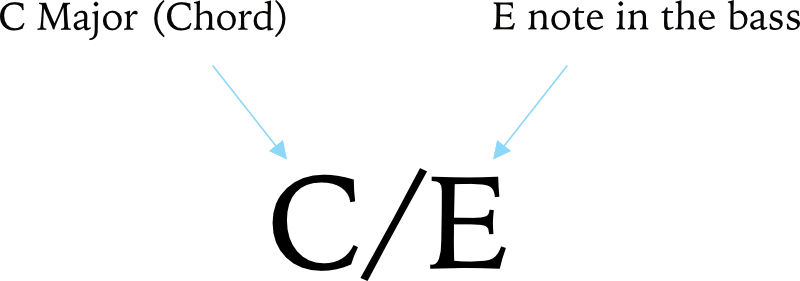
C min/Eb would mean that you play a C minor chord with an Eb in the bass. This would be a C minor in 1st inversion.
Chord inversions on the 6th string
We’ll first cover some chord shapes you can use across the 6th string for Major chords and then for minor chords.
Keep in mind that there are occasions when you can add some open strings if the notes fit the chord structure but in general, you can simply use the shapes here for any chord.
In the following chord charts, the chord tones are written next to each string.
The lowest horizontal line is the thickest string (low E) and the highest horizontal line is your thinnest string (high E).
6th string, 1st inversion Major chord shape 1
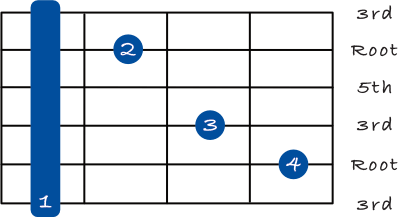
6th string, 1st inversion Major chord shape 2
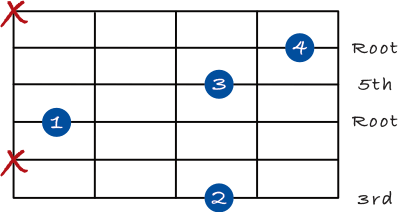
6th string, 1st inversion Major chord examples
As you can see we have the same chord F/A (F over A) but we have two different ways of playing this chord.
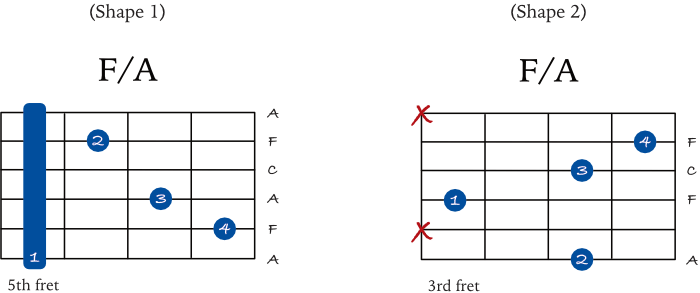
6th string, 2nd inversion Major chord shape 1
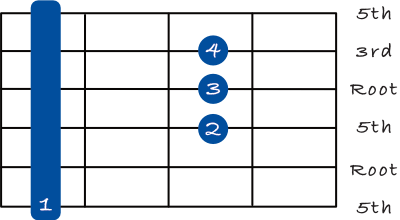
6th string, 2nd inversion Major chord shape 2
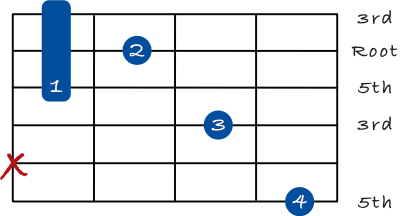
6th string 2nd inversion Major chord examples
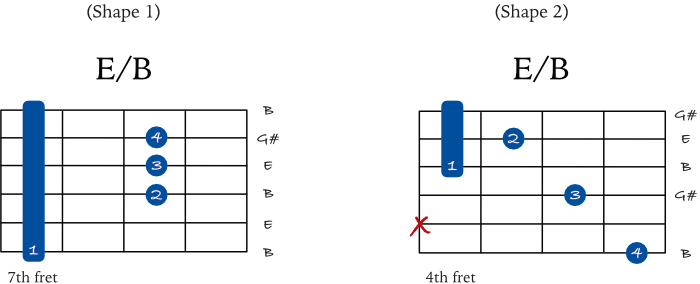
6th string, 1st inversion minor chord shape
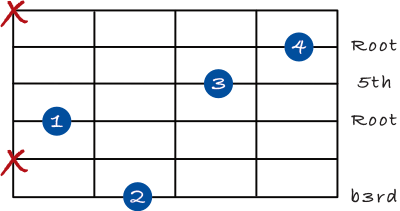
6th string, 1st inversion minor chord shape example
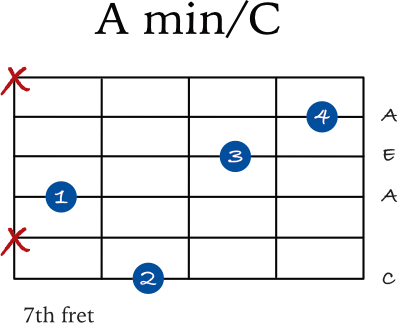
Chord inversions on the 5th string
5th string, 1st inversion Major chord (Shape 1)
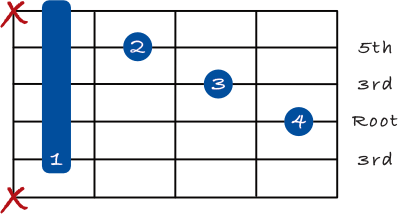
5th string, 1st inversion Major chord (Shape 2)
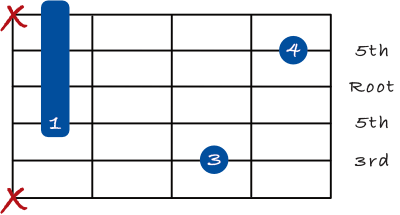
5th string, 1st inversion Major chord examples

5th string, 1st inversion minor chord (Shape 2)
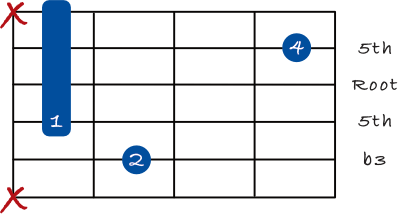
5th string, 1st inversion minor chord (Shape 2) example
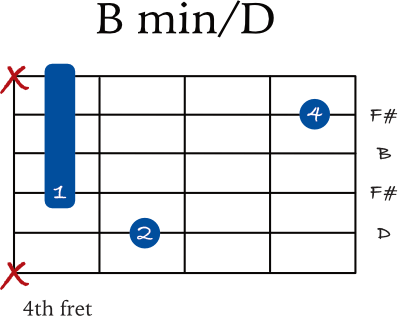
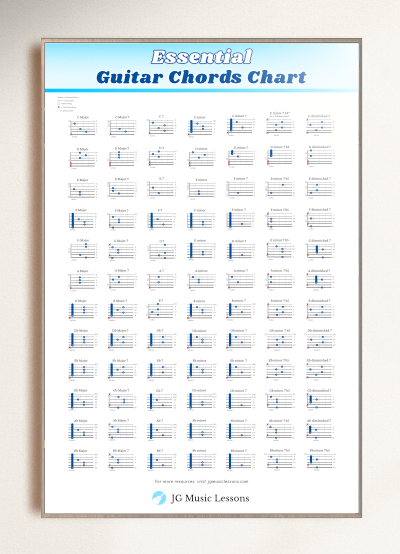
3 chord progression examples using inversions
For the progressions below, you will see a harmonic analysis above the chords to better understand how they relate to each other.
1. Using inversions to walk up the bass line
Instead of using a minor 3 chord to walk up the chords in a progression, you can use the 1 chord in 1st inversion instead. Like this:

2. Using inversions to walk down the bass line
This 8 measure example now walks down the diatonic chords in C Major with a few chord substitution using inverted chords in measures 2 and 6.
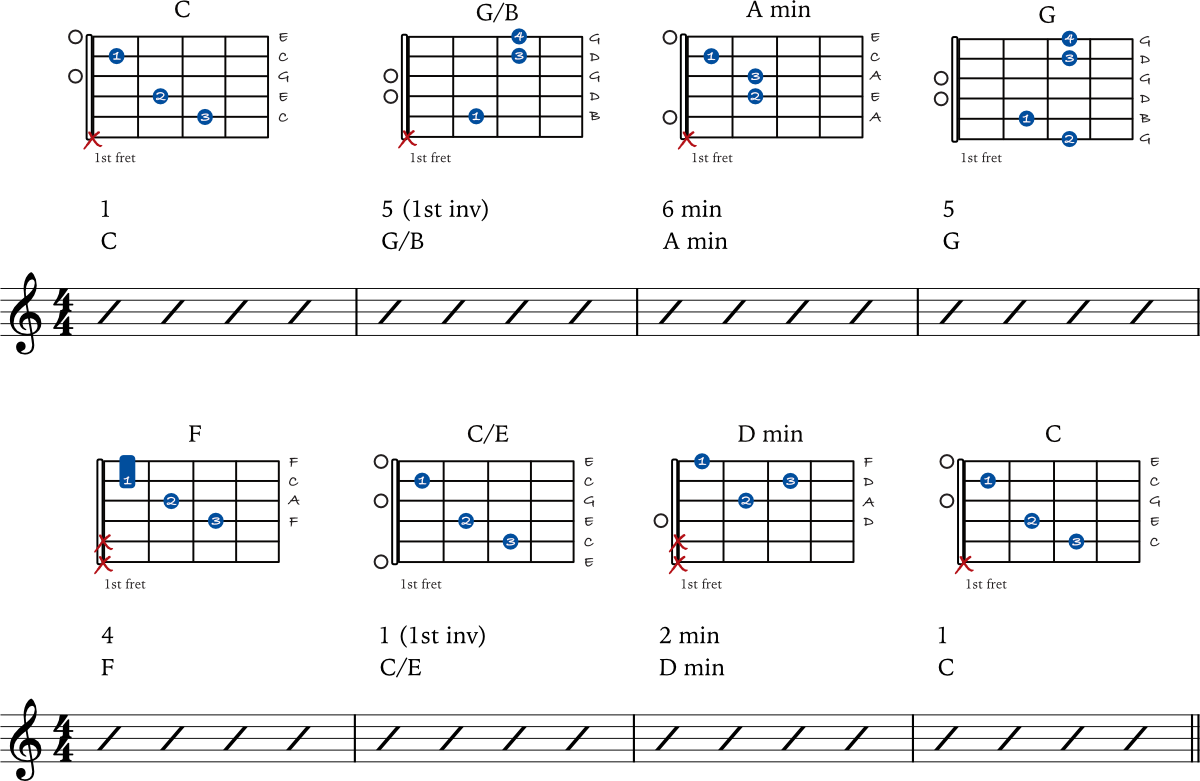
3. Using an inversion as a secondary chord
In this next progression, the second measure uses a secondary chord which means that it functions as a 5 chord of the following chord, even if the chord doesn’t fit in diatonically (related chords of the key).

4. Inversions used a bass pedal
In this progression below I use a flat 6 chord which is considered outside of the A Major diatonic chords. This can also be called modal interchange, where you can borrow chords from other keys.

Are all slash chords inversions?
All slash chords are not inversions of a chord. A slash chord simply states the bass note for a chord but it does not mean that the bass note belongs to the chord’s structure. For example,
C/G means that G is in the bass and yes, the note is part of the triad structure.
The slash chord C/ F would imply a different chord where F is the bass note but is not part of the C triad chord.
For more this subject, check out this other lesson on slash chords.
7th chord inversions
Just like triad chords, 7th chords also have inversions. Since 7th chords have four chord tones, this means that we would also use the 3rd inversion, meaning the 7th chord tone is in the bass.
For example, here are two examples of chords in 3rd inversion.
- C Maj7/B means a C Major 7 chord with a B in the bass.
- C7/Bb would mean a C7 chord with a Bb in the bass.
Check out this lesson to learn the essential 7th chords.
Wrapping up
We covered the 1st and 2nd inversions used for triads chords for Major and minor chords on both the 6th and 5th strings. We also looked at some examples of how to apply inversions in a chord progression to give you a better idea of how they work.
I suggest challenging yourself to go through these chords in various key signatures so that when you come across a song with an inversion, the less you have to think about how to play the chord. It’s always a good practice to try and apply new concepts in all 12 keys when possible.
📘 Get the free guitar practice guide here!
All the best,
JG
Start Playing Better, Faster
by becoming a Pro Member! ✨
Transform your playing by enjoying benefits such as:
• 📙 Exclusive Lesson PDFs and Ebooks
Get access to a growing library of clear, downloadable resources—save time and skip the clutter.
• 🎼 Full Song Lessons
Break down your favorite songs step by step, and play them with confidence.
• 🚫 Ad-Free Learning
Focus better with a distraction-free environment.
• 🎁 Store Discounts
Save 50% off on all song PDFs, charts, audio tracks, bundles, and design printables.
• 💬 Member Support
Got questions? We’ve got your back, helping you stay on track!
👉 Join Here!
Level up with the FREE guitar practice guide and effectively improve your playing! 🎸
Get it sent to your email!

